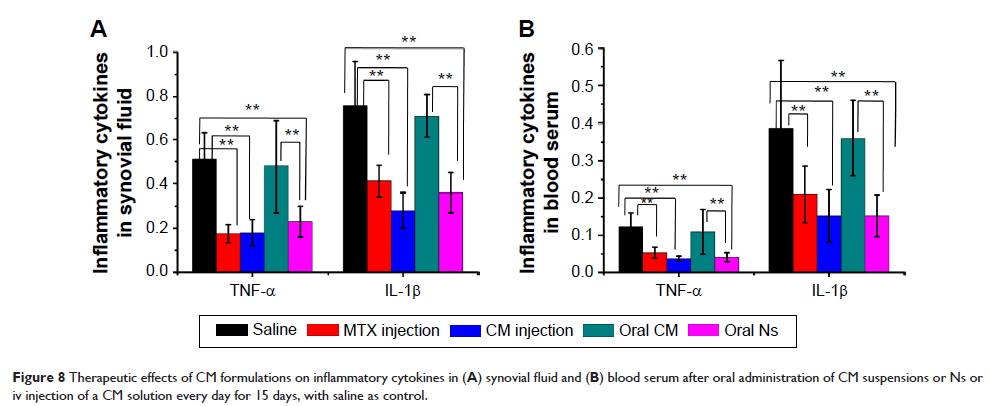9 5 7 4 9
论文已发表
注册即可获取德孚的最新动态
IF 收录期刊
- 3.3 Breast Cancer (Dove Med Press)
- 3.4 Clin Epidemiol
- 2.5 Cancer Manag Res
- 2.9 Infect Drug Resist
- 3.5 Clin Interv Aging
- 4.7 Drug Des Dev Ther
- 2.7 Int J Chronic Obstr
- 6.6 Int J Nanomed
- 2.5 Int J Women's Health
- 2.5 Neuropsych Dis Treat
- 2.7 OncoTargets Ther
- 2.0 Patient Prefer Adher
- 2.3 Ther Clin Risk Manag
- 2.5 J Pain Res
- 2.8 Diabet Metab Synd Ob
- 2.8 Psychol Res Behav Ma
- 3.0 Nat Sci Sleep
- 1.8 Pharmgenomics Pers Med
- 2.7 Risk Manag Healthc Policy
- 4.2 J Inflamm Res
- 2.1 Int J Gen Med
- 4.2 J Hepatocell Carcinoma
- 3.7 J Asthma Allergy
- 1.9 Clin Cosmet Investig Dermatol
- 2.7 J Multidiscip Healthc

姜黄素 (Curcumin) 的效果及其对于在大鼠上佐剂诱发关节炎的纳米处方
Authors Zheng ZL, Sun YH, Liu ZL, Zhang MQ, Li CQ, Cai H
Received 9 June 2015
Accepted for publication 27 July 2015
Published 27 August 2015 Volume 2015:9 Pages 4931—4942
DOI http://dx.doi.org/10.2147/DDDT.S90147
Checked for plagiarism Yes
Review by Single-blind
Peer reviewers approved by Dr Venkateshwar Madka
Peer reviewer comments 2
Editor who approved publication: Professor Wei Duan
Background: Rheumatoid arthritis (RA), induced by the prolonged inappropriate inflammatory responses, is one of the most prevalent of all chronic inflammatory joint diseases. Curcumin (CM), a yellow hydrophobic polyphenol derived from the herb turmeric, has various pharmacological activities against many chronic diseases and acts by inhibiting cell proliferation and metastasis and downregulating various factors, including nuclear factor kappa B, interleukin-1β and TNF-α. Given the pathogenesis of RA, we hypothesized that the drug also has antiarthritic effects. The aims of the present study included the following: 1) examining the therapeutic effect of CM administered via intravenous (iv) injection on RA and 2) formulating the drug into oil–water nanoemulsions (Ns) to overcome the low oral bioavailability of CM and achieve oral delivery of the drug.
Methods: The effect of CM administered through iv injection on adjuvant-induced arthritis in rats was studied in terms of paw swelling, weight indices of the thymus and spleen, and pathological changes in nuclear factor kappa B expression and inflammatory cytokines. Methotrexate was used as a positive control. The CM-Ns were prepared using a high-pressure homogenizing method and characterized with respect to the particle size and morphology. The stability of the CM-Ns in simulated gastrointestinal (GI) fluids and in vitro release were also investigated. A pharmacokinetic study of the CM-Ns and suspensions in which the plasma levels were determined using an high performance liquid chromatography method and the pharmacokinetic parameters were calculated based on a statistical moment theory was also performed in rats.
Results: CM administered via iv injection had a therapeutic effect on RA similar to methotrexate. CM-Ns with a diameter of approximately 150 nm were successfully prepared, and the drug was well encapsulated into the Ns without degradation in simulated GI conditions. The area under the curve (AUC) and Cmax for the CM-Ns were more than threefold greater than those for the suspensions; moreover, similar decreases in the levels of TNF-α and interleukin-1β in both synovial fluid and blood serum were obtained from oral administration of CM-Ns and iv injection.
Conclusion: CM was an effective antiarthritic agent, and the present N formulation appeared to be a promising system that allowed RA therapy with CM to be converted from iv to oral administration.
Keywords: curcumin, nanoemulsions, inflammatory cytokines, adjuvant-induced arthritis, drug release, oral bioavailability
